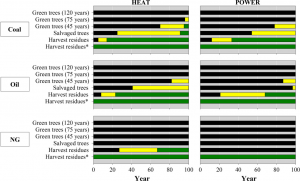
Trees are renewable, so why not let them count under the proposed revisions to the EU renewable energy target? Here we answer this and other questions to demonstrate why burning trees for energy is not inherently climate-friendly.
What is the EU renewable energy target and its relevance to trees?
The European Union (EU) Renewable Energy Directive establishes an overall policy for advancing the use of energy from renewable sources in the EU. The current framework requires the EU to meet at least 20 percent of its total energy needs with renewables by 2020. Wood is currently the largest contributor to this renewable energy target, accounting for as much as 45 percent of all renewable energy consumed. Much of the forest biomass currently used consists of industrial and harvest residues and traditional fuelwood. However, these sources are nearing full exploitation and further demand for wood for bioenergy will likely come from additional tree harvesting. Even now, Europe is importing wood pellets from U.S. and Canadian forests. Proposals currently under discussion by the European Parliament for a revised Renewable Energy Directive would increase the share of renewable energy in the EU’s total energy mix from 20 percent to at least 27 percent, and possibly 30–35 percent, by 2030. This proposal would likely increase demand to turn trees into energy as EU countries seek ways to meet these more ambitious renewable energy targets.
Why aren’t trees a climate-friendly energy source?
There is a common perception that burning trees to generate heat or electricity should be considered “zero emissions” or “carbon neutral” because the carbon dioxide (CO2) released during burning is either recaptured by photosynthesis as trees regrow, or the CO2 already sequestered by trees cancels out the emissions. The reality, however, is more complex for the following reasons:
- When burned, trees generate more CO2 emissions per unit of energy generated than fossil fuels. An oft overlooked fact is that burning wood emits more CO2than fossil fuels per megawatt-hour (MWh) of electricity generated or per unit of heat generated. For example, per data from Laganière et al. (2017), smokestack CO2 emissions from combusting wood for heat can be 2.5 times higher than those of natural gas and 30 percent higher than those of coal per unit of generated energy. In terms of electricity generation, smokestack emissions from combusting wood can be more than three times higher than those of natural gas, and 1.5 times those of coal per MWh.
Originally published on the WRI website.




